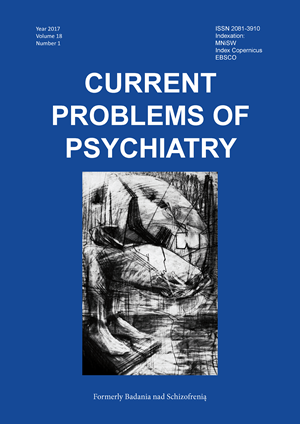Does genius border on insanity? Part I: A relationship between creativity and the presence of psychopathological symptoms in bipolar disorder
DOI:
https://doi.org/10.1515/cpp-2017-0002Keywords:
creativity, bipolar disorder, psychopathology, affective symptoms, artistic talentsAbstract
The theory linking the development of mental disorders with the processes of human evolution assumes that these disorders may be the result of a side effect of natural and sexual selection processes. Creativity is one of the adaptive features associated with the increased incidence of psychopathological symptoms (as compared to the general population).
In this review paper, the definition of creativity has been characterized, and contemporary existing theories on its background, have been presented. Also, the paper describes the relationship between creativity and the presence of psychopathological symptoms. Special attention has been paid to the relationship between creativity and bipolar disorder.
The research results prove the existence of a correlation between a high level of creativity and a higher prevalence of psycho-pathological symptoms, particularly concerning the symptoms of bipolar disorder spectrum.
References
1. Darwin C. The expression of emotions in man and animals. London, Friedman, 1979.
2. Hamilton WD. Narrow roads of gene land. W: Dawkin R, red. The collected papers of W. D. Hamilton. Oxford, New York, W. H. Freeman/Spektrum; 1996.
3. Rybakowski F, Rybakowski J. Ewolucyjne koncepcje zaburzeń afektywnych. Psychiatria Polska.2006; XL; 3:401-413.
4. 2. Andreasen NC. Am J Psychiatry. 1987 Oct;144(10):1288-92.
5. Parandowski J. Mitologia. Wierzenia i podania Greków i Rzymian. Kraków, Dom Książki, 1992.
6. Batey M, Furnham A. Genetic, Social, and General Psychology Monographs.2006; 132(4): 355-429.
7. Stein, M. I. Creativity and culture. Journal of Psychology.1953; 36: 31-322.
8. Runco M., Jaeger J. The Standard Definition of Creativity. Creativity Research Journal.2012; 24(1):92-96.
9. Rybakowski J, Klonowska P, Patrzała A, Jaracz J. Psychopatologia a kreatywność. Psychiatria Polska.2006;(XL)6:1033-1049.
10. Mayseless N, Shamay-Tsoory S.G. Enhancing verbal creativity: Modulating creativity by altering the balance between right and left inferior frontal gyrus with tDCS.Neuroscience. 2015;291:167-176.
11. Carruthers P. Human Creativity: Its Cognitive Basis, its Evolution, and its Connections with Childhood Pretence. Brithish journal for the philosophy of science.2002; 53(2): 225-249.
12. Darwin C. The Descent of Man and Selection in Relation to Sex. London, J Murray;1871.
13. Haselton M.G, Miller G.F. Women's Fertility across the Cycle Increases the Short-Term Attractiveness of Creative Intelligence. Human Nature: An Interdisciplinary Biosocial Perspective [1045-6767]2006;17(1):50 -73.
14. Buss D. The Evolution of Desire: Strategies of Human Mating. New York, BasicBooks; 2003.
15. Treffert D. The savant syndrome: an extraordinary condition. A synopsis: past, present, future. Philosophical transactions - Royal Society. Biological sciences [0962-8436] 2009;364 (1522): 1351-7.
16. Treffert D. An unlikely virtuoso: Leslie Lemke and the story of savant syndrome.Sciences [0036-861X]. 1989;29(1): 28.
17. Brink, T. L. Idiot savant with unusual mechanical ability: An organic explanation. American Journal of Psychiatry, 1980; 137: 250-251.
18. Wallace G. Neuropsychological Studies of Savant Skills: Can They Inform the Neuroscience of Giftedness? Roeper Review [0278-3193]. 2008; 30(4): 229 -246.
19. Barron F.Creativity, Intelligence, and Personality. Annual Review of Psychology. 1981; 32(1):439 -476.
20. Sussman A. Mental Illness and Creativity: A Neurological View of the “Tortured Artist”. Stanford Journal of Neuroscience. 2007; 1(1):21-24.
21. Hankir A. Rewiev: Bilolar Disorders and Poetic Genius. Psychiatria Danubina, 2011;23(1): 62-68.
22. Jamison KR. Mood disorders and patterns of creativity in British writers and artists. Psychiatry 1989; 52: 125-34.
23. Ludwig AM. Mental illness and creative activity in female writers. Am J Psychiatry 1994; 151: 1650-6.
24. Ghadirian A-M, Gregoire P, Kosmidis H. Creativity and the Evolution of Psychopathologies. Creativity Research Journal. 2000-2001; 13(2): 145-148.
25. Runco M. Creativity. Annu. Rev. Psychol. 2004; 55:657-87.
26. Akiskal H.S, Akiskal K. Re-assessing the prevalence of bipolar disorders: clinical significance and artistic creativity. Psychiatry Psychobiol. 3 European Psychiatry. 1988.
27. Richards, Ruth, Kinney, Dennis K, Lunde, Inge, Benet, Maria, Merzel, Ann P.C. Creativity in manic-depressives, cyclothymes, their normal relatives, and control subjects. J. Abnorm. Psychol. 1988; 97 (3): 281-288.
28. Sass L.A. Schizophrenia, Modernism, and the "Creative Imagination": On Creativity and Psychopathology. Creativity research journal. 2001; 13(1):55-74.
29. Simonton D.K. Creativity: Cognitive, personal, developmental, and social aspects. American Psychologist, 2001; 55(1): 151-158.
30. Andreasen N. Creativity in art and science: are there two cultures? Dialogues in clinical neuroscience. 2012 14(1):49-54.
31. Rybakowski J. Oblicza choroby maniakalno-depresyjnej. Poznań, Termedia Wydawnictwa Medyczne; 2009.
32. Andreasen N. The relationship between creativity and mood disorders. Dialogues in clinical neuroscience. 2008; 10(2)2: 251-255.
33. Prisciandaro J.Predictors of clinical trial dropout in individuals with co-occurring bipolar disorder and alcohol dependence. Drug and alcohol dependence. 2011; 118(2-3):493-496.
34. Ludwig A. Creative achievement and psychopatology. Comparison among professions. In: Runco, M. Richards, R. Emintent creativity, everyday creativity, and health. Ablex, Greenwich. 1997.
35. Soeiro-de-Souza M.G. Soares D, Post R, Moreno R.A. Creativity and executive function across manic, mixed and depressive episodes in bipolar I disorder. Journal of Affective Disorders. 2011; 135(1): 292-297.
36. Kusz W. Biografia Roberta Szumana widziana oczami psychiatry. Current Problems Of Psychiatry. 2010; 11(4): 313-322.
37. Ostwald P, Schumann: The Inner Voices of a Musical Genius. Boston, Northeastern University Press. 1985.
38. Holm-Hadulla R.M., Goethe’s study crisis, depression and his selftreatment strategies. Psychotherapeut. 2009; 54: 370-374.
Downloads
Published
Issue
Section
License
Copyright (c) 2017 Authors

This work is licensed under a Creative Commons Attribution-NonCommercial-NoDerivatives 3.0 Unported License.


